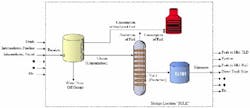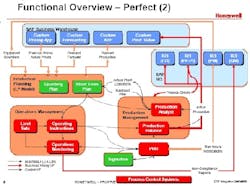CONNECTING YOUR process control system to enterprise software (ES)—enterprise resource planning (ERP), accounting, management execution system (MES), maintenance and/or supply chain management, to name a few—can be a difficult and expensive job. Is it worth it? Perhaps a new version of an old joke explains it best:
A control engineer comes home and announces to his wife: “We finally finished that enterprise integration project!”
“Did you get a big raise?” she asks.
“I did even better than that. I saved the plant and kept my job!”
In this article, we’ll cover why you do enterprise integration, how you make the connection, and how it helps you keep your job. Also, we found a government mandate that may give you the legal incentive you need to finally integrate your enterprise (Of course, it also might just be another ISO 9000/Y2K-type enterprise integration boondoggle that will annoy you and cost a fortune in consulting fees for dubious benefits.)
Acronyms R Us: From ERP to ES
Since ERP first landed in our industry, we’ve heard disparaging words from control engineers and vendors. Way back, when ERP first hit the scene, one anonymous plant manager resisted it at all costs, figuring that ERP was just a way for upper management to figure out which plants to close. He was probably right at the time. ERP never did anything for you, but it sure closed a lot of marginal plants.
People still complain about ERP today. “ERP never really worked anyway,” said Dave Shook, marketing manager at Matrikon, in “Serving Up Asset Management,” CONTROL, Nov. ’05, p. 44. “The dirty little secret of ERP software is that it’s used for financial and ancillary functions instead of driving manufacturing decision-making,” he says. “In process manufacturing, ERP has been a pretty big bust.”
As you can see in an ERP view of a plant (See Figure 1 below), all ERP software seems to care about is the “goesintas” and the “goesoutas.” These are numbers that you already know about, and probably gather for the ERP software.
FIGURE 1: “GOESINTAS” AND “GOESOUTAS”Before going to work for Yokogawa Corp. of America five years ago as a productivity consultant, Fred Woolfrey was an end user, who still remembers ERP’s early days. “I worked on integration between SAP and plant operations,” he remembers. “The integration went from SAP orders, daily receiving, and daily shipping information through planning and scheduling models, and onto the desks of plant personnel responsible for plant schedules. The system included notification back to SAP about daily information on the actual shipments and receipts, and on changes made to the recommended schedule. The link from the plant schedule to the plant control system was accomplished manually.”
Many of you probably remember such a scenario in the “bad old days” of ERP. For this article, we’ll lump ERP, maintenance and/or supply-chain management, MES, asset management and similar software together under ES.
It’s what ES does with these numbers that has gotten better over the years. “Manufacturing or plant operations is right in the middle of the plan-source-make-deliver supply chain for most manufacturing companies,” says Mike Paulonis, technical associate at Eastman Chemical Co. in Kingsport, Tenn. “If communication and integration between various entities comprising the supply chain is poor, there will be inefficiency, waste, and problems. Companies at the leading edge of integration benefit from lower costs, higher productivity, higher quality, greater customer satisfaction, and higher profits.”
Paulonis explains plant-to-enterprise integration isn’t fueled by accounting. “It's not driven by benefits to plant constituencies either,” he adds. “It's driven by a company-level need to improve productivity, lower costs, and compete in the global marketplace.
“Plant folks have a legitimate complaint about being whipsawed by changing demand forecasts and changing production plans,” he notes. “If the plant has greater visibility to demand and planning information, then fewer surprises and last-minute changes will result. Most in plant operations would like to help the bottom line, and bring recognition to themselves by minimizing production costs.
nfortunately, it may not be obvious how to do that without enterprise-level information. By bringing real-time cost information down to the plant floor, better minute-to-minute and day-to-day decisions can be made to optimize profit.”
So, what does all this mean to you, out in the plant? Refer to the joke above, and understand that if you don’t optimize profit, minimize production costs, and secure all the other benefits Paulonis is talking about, then your accountant-managers might close your plant and move it to a third-world country. Therefore, you want to accomplish enterprise integration to keep your job.
Benefits of Enterprise Integration
Marc Leroux, product marketing manager at ABB also echoes Paulonis’ comments. “To date, the vast majority of the connections have been limited to production requirements and costing information. This is a start, but certainly not what CEOs envisioned when they invested millions of dollars in ERP implementations. To execute on this vision, the manufacturing organization must become ‘transparent.’ As companies focus on improved customer service, the demand for much tighter integration will become higher than we can presently envision,” he concludes.
Todd Stauffer, PCS 7 marketing manager at Siemens, agrees. “Enterprise integration can also mean increasing the quality of the manufactured products,” he says. “Optimization of production assets can’t be performed by relying only on the capabilities of the process control system. Truly optimizing the performance of these assets requires looking at the incremental benefits that can be achieved by using MES, ERP, CMMS, asset management, advanced diagnostics, loop tuning and advanced control.”
Pat Kennedy, CEO of OSIsoft, says ES is profitable. “Although there have been a lot of painful mistakes with ERP implementations, high value is precisely the reason that they keep trying,” he notes. “We had one pulp and paper user that set up an energy trading desk for five paper mills. They invested $70,000 and made $1 million, and will make the same $1 million per year forever. We had a power utility user that set up remote operations and management for their power stations and reported a $3 per year return for every $1 spent. We had a steel complex that reported a +20% increase in plant availability by going to proactive instead of reactive maintenance. Those that confine their operations and analytics skills to inside the process control network are toast.”
“The ultimate objective is real-time, closed-loop business control via what we call ‘real-time finance’,” says Peter Martin, VP of Invensys Process Systems. “To provide the process and business measurements and information flows needed to implement real-time finance, plant and enterprise systems and applications must not just be connected, but actually unified into a single ‘system.’ This departs dramatically from the traditional view that real-time control systems and transactional business systems are in entirely separate domains.
“With such a unified system, users could, for example, take advantage of the real-time calculation capability in the control systems to calculate accounting information in real time; aggrandize that information to shift daily and weekly accounting totals in the plant historian; then merge that information into the ES finance system. In another example, real-time condition monitoring information developed in the control and maintenance systems can be used to trigger an appropriate action in the business system, as determined by current business objectives.”
Jeffery Cawley, market development VP at Northwest Analytical, agrees that process control and ES are becoming unified. “If manufacturing firms are going to run their enterprise based on key performance indicator (KPIs), then information from both process and enterprise systems must be combined,” he explains. “That’s why enterprise applications need access to process system data. The reverse also is true: the people running the process need to be able to incorporate selected KPIs in decision making, and need to do much better at asset management, which requires information that is owned by the enterprise applications.”
Cawley adds control system vendors are making money from all this. “Control system vendors are moving up the system levels much like the ERP vendors are moving down. This product line diversification is designed to expand their market opportunities. The line dividing functions between the ERP and related applications (MES, SCM) is becoming blurred as manufacturing management and enterprise applications take on functions like asset management and scheduling.”
Woolfrey of Yokogawa agrees about the need to provide access both ways. “The information ES holds that is critical to plant operations comes from their role in managing the plant’s supply chain and in managing the plant’s equipment maintenance,” he says. “ES contains important information about the quality, cost, and timing of raw materials delivered to a plant; the plant’s production schedule; and the quality, sales price and timing of shipments to customers. Important information held by ES about plant maintenance includes parts availability, repair schedules, and personnel required to make repairs.”
Going the other direction, he says, “Plant control systems hold large amounts of information as well, but the critical information they hold for ES are rates and conditions of plant operations and the status of equipment. Plant control systems hold information about the actual quantity and quality of raw materials, plant capacity, current and historical production rates, the quality and location of finished products, and the usage and condition of plant equipment.”
How does all this benefit the control people? One benefit is eliminating the “whipsaw” effect that Paulonis observed. “When a supplier ships raw materials, the ES knows the quality and quantity of those shipments, and can notify the plant control system,” says Woolfrey. “When a customer places or removes orders, the ES can again promptly notify the plant control system.”
Next, there’s ES software’s maintenance benefit. “If a piece of equipment fails or is predicted to fail, the plant control system can ask the ES to help develop a repair schedule based on its knowledge of the plant’s production schedule, maintenance parts, and personnel availability,” he says.
Chris Boothroyd, product manager at Honeywell agrees. “After production plans and schedules, by far the most common example of plant-relevant information are maintenance plans and history,” he says. “Customers want to view near-real-time information about a pump or vessel to monitor the process and/or equipment performance. However, when something goes awry, they also want to know what the most recent maintenance activity was on that pump, and when the next planned maintenance will occur. Of course, they can get this information from the ERP system, but only by logging on to ERP, remembering the correct transactions, finding the right equipment, running the right report, etc. It’s simply too hard and wastes too much time.”
ES provides another benefit to plant operations people outside the control room. “Many individuals throughout the enterprise have no access to the control room, yet need process data to make decisions,” says Jonas Berge, marketing manager at SMAR. “For this reason, a connection is needed from the process automation system to the rest of the organization. For example, each plant may have a team dedicated to performance improvement. The software they use needs access to all process data to access the control loops to compute variability, error, output standard deviation, and detect oscillation, etc.”
Ken Smothers, principal engineer at Aquila Networks, a group of Kansas City-based power companies, adds, “Our control system vendor only provided the software to allow us to see data on the historian,” he says, so Aquila connected to the company network itself. “The primary purpose of the connection is to provide steam sales data to the billing clerk. Additional benefits include providing historical data and troubleshooting information to specific personnel, who don’t reside at the plant. We’re doing it by providing a link from the historian through a switch, which goes through a firewall, into a router, and then connects to the company network. The selected individuals can then connect to the historian via software loaded on virtual servers running on a VSWorks platform.”
Quality control efforts benefit from these links, says consulting engineer Paul Wiancko, principal at PRT Wiancko & Assoc. “Another reason for high-end collection of process data is for quality control work,” he says. “For some products, it’s desirable to link final test results with process parameter history on an ongoing basis. Some customers want to go back to the supplier, and see how the process ran at the time of production. Higher-end software can collect, organize and suitably present this data, but sometimes it needs specialized software to make the transition.”
Coincidentally, just when you see enough positive benefits to justify ES, along comes another government mandate that may require you to do enterprise integration: Sarbanes-Oxley.
Sarbanes-Oxley: Another Y2K?
Sarbanes-Oxley (SOX) regulations make a company’s CEO and CFO personally responsible for everything that appears in their quarterly and financial reports, under penalty of fines and imprisonment. “I think this is the next Y2K, although there are some good practices that can be implemented,” says OSsoft’s Kennedy. “Those assigned to the SOX project are generally not those that know what to do.”
A recent poll of CONTROL’s subscribers says that none of the respondents have had to provide information about plant operations yet, but it’s certainly coming soon. SOX is yet another Y2K/ISO 9001 brouhaha that’s likely to plague you.
Leroux of ABB says SOX isn’t that just coming temporarily, but will be here to stay. “While SOX is seen as primarily at the business level, most organizations feel SOX may require some interaction with manufacturing, particularly to address processes that impact a firm’s finances.”
Robert Fallwell, manager of measurement engineering services at Emerson Process Management, says your company’s accountants and outside auditors already are working their way down to you. That’s because the SOX auditors want to make sure the critical data that goes into the annual report is accurate.
“Flow measurements are most important for oil, gas, and many process industries, because they’re literally the company’s ‘cash register’,” says Fallwell. “All revenue and most of the cost data reported by a company is generated from or related to flowmeters and associated equipment.”
Most of that information is already being shipped to your company’s ERP system, but how accurate is it? Fallwell says, “When the SOX auditors arrive at your plant, they’ll want you to prove that these measurements are accurate, that you have procedures in place to ensure measurement accuracy, and that the plant’s operators, engineers and production accountants are trained in the correct procedures for the measurement control process.”
Essentially, you have to provide your company executives with “reasonable assurance” that the data is good, and that you can detect and fix any flow errors that come up. Fortunately, Fallwell says you won’t have to prove the accuracy of every flow measurement in the plant or refinery—just the ones that feed the cash register. However, complying with SOX requirements will mean more data, audit trails and tracking information that you’ll have to integrate with enterprise software. In fact, if you haven’t integrated your enterprise, SOX may make it a requirement.
“Sarbanes-Oxley will require an applied business process that relates to ERP integration, and the information that comes out of the plant to translate into financial numbers,” says Honeywell’s Boothroyd.
How to Integrate
The myriad connections and links among a process control system and ES may looks daunting (See Figure 2 below), but making connections to integrate the enterprise with a process control system may not be as hard as you think. It will be expensive and time consuming, of course, but if you use a control system from almost any major vendor, all the software and interface hooks already are available.
FIGURE 2: ES IS A MESS
One “corporate guy,” who responded to our survey, connects through historians. “We have many mills, and each do different things,” he says. “Newer, large installations funded by corporate try to make the existing work with the new. All of our DCSs have their own historian that records everything, and they all have PI interfaces that run independently of the DCS historian. These also collect data via OPC in mills with multiple DCSs. Most mills have two layers of connectivity, but the new security model has three layers: process control, manufacturing, and business.”
According to our survey, 56% of our respondents did enterprise integration themselves, and 37% had a control system vendor do it.
|
WHAT THEY SAY |
Cawley concurs. “You’ll probably need either an in-house or an external systems consultant to design and configure usable systems,” he cautions. “These systems typically require a level of system view and integration experience that isn’t usually resident in the control engineering staff. This also is true because many manufacturing companies have seriously reduced their ability to perform these integration tasks with existing staff. But, as long as the integration is standards-based and doesn’t require significant amounts of custom programming, it will be maintainable and can be adapted to changing conditions.”
One user responding to the survey reported setting up a special processor, which only gathers data from different PLCs and sends it upstairs. “The physical link is via the proprietary network of the PLC manufacturer,” he explains. “The processor, a PLC with Ethernet capability, connects via the factory LAN to a server that collects the data. Using SQL software, this data is formatted for display on PCs, replacing the manual log-sheet. This same software can generate reports with summaries of the data that was gathered.”
Kennedy also suggests setting up a dedicated server. “First, mirror the data into the IT environment because this integration doesn’t occur at the plant floor,” he advises. “You then have to build a server that can interpret the transactions, aggregate the information, and send it to the ES. We make a product called RLINK that does this. SAP makes a complete infrastructure, and just bought Lighthammer to add some applications to make this easier. No other software needs to be added because all process control systems already come with the interfaces to talk to the modules that mirror the information into the IT space.”
If you don’t have this capability in your system, other solutions are available, he says. “SAP has a program for certifying interfaces, and the vendors that provide this are on their web site. There are other ways of interfacing, such as sending data to the database that SAP uses, but now you’ll need mainframe consultants to get into SAP. I would advise users not to attempt this on their own.” Other software solutions we found include:
- Wonderware, which provides ISA S95-compatible XML standards to connect its ArchestrA architecture to SAP’s NetWeaver;
- Progilent, from Averna Technologies, which uses National Instrument’s LabView software to gather data and connect it with a variety of ES and plant floor systems;
- Informance’s, which uses a “hub and node” architecture to connect ES in a central location to local plants; and
- InduSoft’s Web Studio HMI/SCADA software, which provides direct access to standard SQL databases.
Martin of Invensys says standards also will help with integration. “Emerging standards such as ISA S95, MIMOSA, and OPC play an important role in creating a unified system by providing flexible, yet robust and secure interoperability between disparate systems and applications,” he explains. “S95 provides the appropriate schema for operations data. MIMOSA provides the schema for maintenance data. OPC provides the messaging services at the plant level. And open technologies such as Microsoft Corp.’s BizTalk provide communications services between plant and enterprise applications.”
Berge of SMAR likes OPC. “OPC-XML-DA and OPC-UA are creating a market in which plants and service providers all use the same technology, thus enabling advanced control, optimization and asset management to be done remotely by third-parties at market-based prices,” he says. “In the past the remote application was almost always a ‘dumb’ web browser that only displayed data. Seldom or never was there any application that did something clever with the data such as process optimization. With OPC-UA, it’s much easier to tie in "intelligent" applications that can receive data, process it, and send it back across the web.”
ES Work Goes Ever On
There is no end to enterprise integration. Next year, there may be a new ES package that needs to be integrated, or another Y2K/SOX “crisis” for you to deal with. As the “corporate guy” puts it, “While the process control side of the activity has long been prepared for this, we’ve been ‘installing’ SAP for several years. So far, very little useful information has been moved from our process control systems into SAP.”
Still, the potential benefits for enterprise integration can help make your plant more economical, efficient and profitable, so management will keep the plant open and you get to keep your job.

Leaders relevant to this article:






